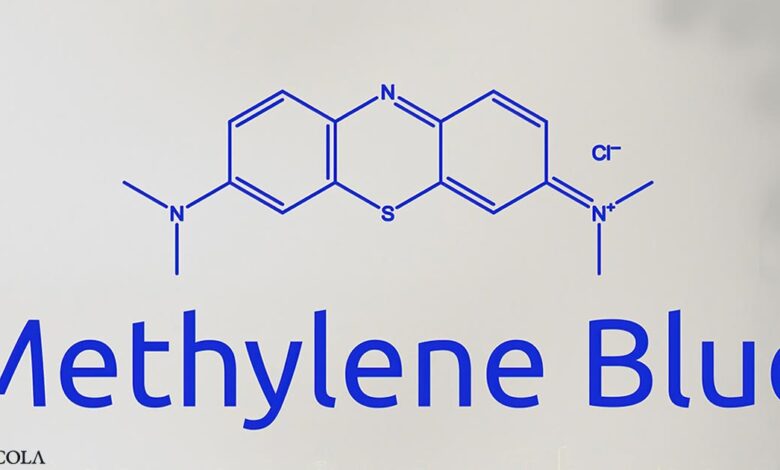
I thought it was time for an update for methylene blue. I have included the previous interview I did with Dr. Francisco Gonzalez-Lima two years ago. My views on the use of this drug have changed since that time and I thought I’d like to give you an update as to my current thoughts on this interesting molecule.
Methylene blue is the precursor molecule for hydroxychloroquine and chloroquine. It is a fascinating compound with a wide range of health benefits. Methylene blue is a dye first created in 1876. Originally used in the textile industry, it later found applications in medicine due to its antimicrobial properties.
Methylene blue remains an important part of the strategy’s used in hospitals worldwide due to its unique ability to counteract mitochondrial metabolic poisons. These are typically molecules that disrupt the flow of electrons in the complexes of the electron transport chain of the mitochondria.
In cases of carbon monoxide or cyanide poisoning, for instance, medical professionals administer methylene blue intravenously as a primary treatment. Today, it’s gaining further attention in the natural health community for its ability to promote healthy skin, slow skeletal aging, support brain health and more.
Key Benefits of Methylene Blue
Methylene blue is a multifaceted compound with diverse uses, but its most notable impact is on how cells produce energy. It primarily works by interacting with the mitochondrial electron transport chain, which plays a vital role in cellular energy generation.
During normal cellular respiration, electrons from the food we eat are passed through a series of protein complexes within the mitochondria. This process, called the electron transport chain, ultimately results in the production of ATP, the energy currency of cells. In this chain, oxygen acts as the final electron acceptor.
What makes methylene blue special is its ability to accept electrons and transfer them directly to oxygen, effectively creating a shortcut in the usual electron transport chain. This alternative pathway can boost energy production, especially in situations where normal cellular processes are compromised or not working at full efficiency.
By enabling more effective electron transfer and energy generation, methylene blue has the potential to enhance various aspects of how cells function and overall health. This ability to interact with and optimize cellular energy processes is what makes methylene blue a topic of interest in both scientific studies and potential medical applications.
Improved Mitochondrial Function
One of the most exciting aspects of methylene blue is its potential to improve mitochondrial efficiency and increase cellular energy. This improvement in cellular energy production has wide-ranging benefits throughout your body. Whether it’s healing, neurotransmitter production or any other cellular function, optimized mitochondria help your body perform at its best.
Even in healthy individuals, low doses can improve the body’s energy production systems. It enhances oxygen use, mitochondrial function and ATP generation beyond normal levels, essentially fine-tuning the entire metabolic process. This means it serves as both a performance booster for cellular energy production and a remedy for metabolic disruptions.
Furthermore, methylene blue’s impact on mitochondrial respiration is linked to broader positive effects. It stimulates your body to increase its oxygen-processing capabilities overall. Additionally, it influences blood flow dynamics, leading to improved blood supply to various tissues. These combined effects contribute to its potential as a metabolic optimizer.
Impressive Cognitive Support, Including Against Alzheimer’s Disease
Methylene blue has a particular affinity for neurological tissue and has been investigated for various psychiatric disorders, including manic states and depression. Crawford states, “It does have an influence on the central nervous system … Some of this is not extremely well defined. It does seem to have a positive impact on dopamine and dopamine systems. It definitely influences serotonin and your serotonergic systems.”1
In one study, methylene blue was given to patients with manic depression, also known as bipolar disorder, who didn’t respond to conventional treatment. Fourteen of them showed “definite improvement” as a result.2 In a separate three-week trial, methylene blue led to significantly greater improvement than placebo in people with severe depressive illness.3
Ironically, you may have heard of methylene blue as a fish tank treatment, but this humble compound is now at the forefront of Alzheimer’s research as well. A study revealed that a stabilized form of methylene blue, called hydromethylthionine (LMTM), slows cognitive decline and brain atrophy in mild to moderate Alzheimer’s disease patients.4
Unlike current treatments that only temporarily mask symptoms, LMTM inhibits the aggregation of tau proteins in the brain. Even at low doses, LMTM demonstrates significant benefits. The study found that patients with plasma concentrations as low as 0.4 to 0.8 ng/ml showed improvements in cognitive function and reduced brain shrinkage. According to study author Claude Wischik of Aberdeen University:5
“In addition to the reduction in brain atrophy, we were surprised to see the large cognitive effects of treatment in the patient group with the higher blood levels of hydromethylthionine at the 8 mg daily dose.
According to scores from the ADAS-cog scale, the effect was around 7.5 points, or three times that seen from current routine Alzheimer’s treatments, and would be equivalent to an 85% reduction in cognitive decline over 65 weeks.”
The researchers discovered that LMTM’s effects plateau at higher concentrations, showing that there’s no need for excessive dosing to achieve optimal results. Importantly, methylene blue is a hormetic drug, which means that low doses have the opposite effect as high doses.
For example, it’s primarily used in emergency rooms at the upper dosage limit (3 milligrams to 4 mg per kilo of bodyweight) for methemoglobinemia,6 which is when a metabolic poison interferes with the transport of oxygen in hemoglobin, by the iron in hemoglobin being oxidized to +3 rather than its normal reduced +2 state.
However, if you take too high a dose, you produce methemoglobinemia. At dosages in between, there’s no effect. Likewise, while low dosages have an antioxidant effect, high doses are pro-oxidative and can kill bacteria and tumor cells.
Protect Liver Health
Methylene blue shows promise to be a helpful in treating fatty liver conditions, offering hope for those struggling with steatosis (fatty liver disease) and steatohepatitis, an advanced form of fatty liver disease. At the heart of methylene blue’s liver-protective effects is its ability to activate SIRT1, a protein often referred to as a “longevity gene.”7
SIRT1 plays a crucial role in maintaining energy balance in your body, similar to the effects of calorie restriction. By increasing SIRT1 levels, methylene blue sets off a cascade of beneficial effects. It enhances mitochondrial function, leading to improved energy production and utilization. This activation mimics the benefits of calorie restriction without the need for drastic dietary changes, offering a more accessible way to support your liver health and overall wellbeing.
One of the most promising aspects of methylene blue’s action is its ability to combat excessive fat accumulation in the liver. The study showed that methylene blue activates AMPK, an enzyme that acts as a metabolic master switch.8 This activation leads to increased fat burning and decreased fat production in the liver.
Additionally, methylene blue was found to enhance the activity of CPT-1 and PPARα, two key players in fat metabolism. These effects collectively work to reduce the buildup of harmful fats in your liver cells, reversing or preventing fatty liver disease.
Beyond its fat-reducing capabilities, methylene blue helps protect your liver from the effects of a high-fat diet. In mice fed a high-fat diet for eight weeks, treatment with methylene blue significantly reduced liver fat accumulation and inflammation.9 This is particularly exciting because it suggests that methylene blue is effective not just in preventing liver damage, but also in treating existing conditions.
By activating SIRT1 and promoting mitochondrial health, methylene blue helps your liver cells become more resilient to stress and better equipped to handle the challenges of modern diets high in processed foods and unhealthy fats.10
Methylene Blue Enhances Estrogen Metabolism: A Key to Hormonal Balance
In addition to its effects on fat metabolism, methylene blue plays an important role in your liver’s ability to process estrogen. This function is vital for maintaining hormonal balance, which affects numerous aspects of your health. Research dating back to early studies has shown that B vitamins, particularly B1 (thiamine) and B2 (riboflavin), are essential for your liver’s ability to deactivate and metabolize estrogen.11
Interestingly, other studies have found that this process can be further enhanced by adding niacinamide (a form of vitamin B3) and methylene blue to the mix.12,13 Methylene blue’s role in this process is particularly fascinating. Under normal conditions, your liver needs oxygen to break down estrogen effectively. However, in situations where oxygen might be limited, methylene blue steps in as a powerful ally.
It acts as a substitute electron acceptor, essentially mimicking the role of oxygen in the estrogen breakdown process. This means that even in less-than-ideal conditions, methylene blue helps your liver continue its crucial task of managing estrogen levels.14
Moreover, the combination of methylene blue with niacinamide is particularly effective. Niacinamide helps maintain levels of NAD+ (nicotinamide adenine dinucleotide), a crucial molecule for many cellular processes, including estrogen metabolism. By preserving NAD+ levels, niacinamide ensures that your liver has the resources it needs to process estrogen efficiently.15
When combined with methylene blue’s ability to function in low-oxygen environments, this creates a powerful duo for supporting your liver’s hormone-balancing functions. This multi-faceted approach to liver health — addressing fat metabolism, inflammation and hormone balance — underscores methylene blue as a versatile tool in your health arsenal.
By supporting these crucial liver functions, methylene blue offers a comprehensive approach to maintaining liver health and, by extension, your overall wellbeing.
A Powerful Anti-Inflammatory Agent
Methylene blue also offers significant benefits in fighting inflammation. Research uncovered its potential to inhibit inflammasomes — protein complexes in your immune system that trigger inflammatory responses.16
The study found that methylene blue can block multiple types of inflammasomes, including NLRP3, NLRC4, and AIM2. This broad-spectrum anti-inflammatory action sets methylene blue apart from many other treatments that only target specific inflammatory pathways. Additionally, methylene blue was shown to reduce the production of proinflammatory molecules like IL-1β and IL-18.
These findings suggest that methylene blue could be helpful in managing various inflammatory conditions. The compound also demonstrated an ability to improve mitochondrial function and reduce oxidative stress, which are key factors in many chronic diseases. By addressing inflammation at multiple levels, methylene blue offers a promising approach to supporting your overall health and preventing or managing inflammatory disorders.
The study’s animal experiments further highlighted methylene blue’s therapeutic potential. When mice were given lipopolysaccharide (LPS) to simulate severe inflammation, treatment with methylene blue significantly increased their survival rates, suggesting that methylene blue could be beneficial in managing severe inflammatory conditions like sepsis.17
The compound also reduced inflammation in a model of Listeria infection, demonstrating its versatility in addressing different types of inflammatory triggers. Importantly, methylene blue’s effects were observed at doses comparable to those already used safely in humans for other medical purposes.
From reducing the risk of complications after surgical procedures to helping with chronic inflammatory conditions, methylene blue’s wide-ranging effects on inflammation make it a compound worth keeping an eye on for your health toolbox.
Protection from EMF Exposure, Healthier Skin and Other Benefits
In our increasingly wireless world, electromagnetic fields (EMFs) are significant concern, but, in addition to minimizing your exposure, methylene blue can help. “Non-native EMF exposure is a problem,” Crawford says. “Methylene blue will help with radiation exposure. Very important, and another big reason that I take it every day.”18
Research also suggests methylene blue helps promote youthful skin by reducing reactive oxygen species, stimulating cell proliferation and upregulating antioxidant defenses.19 Another study published March 2024 in the journal Aging investigated how methylene blue improves skeletal aging when administered over a long-term period, supporting bone health.20
I also recommend having methylene blue readily available at home in case of a heart attack. While sudden death is the most common symptom of heart disease, surviving individuals face the serious threat of reperfusion injury, where cellular dysfunction and death may worsen following the restoration of blood flow.
Methylene blue administration can significantly mitigate tissue damage; however, proper dosage is crucial to avoid overdose. Administer methylene blue within minutes of the cardiac event to meet the critical time threshold.21
Methylene Blue Side Effects
While methylene blue has an impressive safety profile when used appropriately, there are some important considerations:22
1. Blue discoloration — Methylene blue will temporarily turn urine and sometimes your tongue blue. This is harmless but can be startling if unexpected. This typically occurs when the dose is larger than 30 to 50 mg which is a dose about ten times higher than I recommend for most.
2. Interference with pulse oximeters — High doses of methylene blue can affect pulse oximeter readings.
3. Serotonin syndrome risk — I would advise strong caution for anyone ever to take an SSRI drug. I don’t believe anyone benefits from them and would encourage you to read my last article on SSRIs. Taking methylene blue only worsens this risk as they increase serotonin levels even further.
This typically only occurs at high doses that are used to treat life threatening situations and is likely rarely, if ever, occur at lower doses that I recommend of 3 to 5 mg. This mostly occurs in those on SSRI drugs and taking doses of methylene blue over 100 mg.
4. Kidney concerns — Those with severe renal insufficiency should use caution and work closely with a health care provider.
5. G6PD deficiency — Methylene blue is contraindicated in patients with this genetic disorder.
The most common side effects related to methylene blue involve gastrointestinal discomfort, including nausea and diarrhea, which are typically mild and transient. However, allergic reactions, ranging from skin rashes to life-threatening anaphylaxis, are also possible.
Neurological effects such as headaches and confusion can occur, with high doses potentially triggering serotonin syndrome, especially in patients taking serotonergic medications.23 For individuals with glucose-6-phosphate dehydrogenase (G6PD) deficiency, methylene blue can cause hemolytic anemia, making it crucial to screen for this genetic condition before administration.
Cardiovascular effects, though less common, may include increased blood pressure and palpitations. Importantly, methylene blue can interact with various medications, particularly antidepressants and antimalarials, altering their efficacy or causing adverse reactions.
Avoid Using Methylene Blue Solutions
Dissolving methylene blue in water can lead to a significant decrease in its effectiveness after 48 to 72 hours for several reasons:
1. Photodegradation — Methylene blue is sensitive to light, particularly UV radiation. When exposed to natural or artificial light, the chemical structure of methylene blue can break down, resulting in a loss of its therapeutic properties. This degradation process is accelerated when the compound is dissolved in water and exposed to light, diminishing its effectiveness.
2. Chemical reactions — In aqueous solutions, methylene blue can undergo redox reactions, especially in the presence of other substances that may act as reducing agents. These reactions can alter the chemical structure of methylene blue, reducing its ability to function effectively as a medication.
3. Adsorption to container surfaces — Methylene blue molecules can adsorb onto the surfaces of the container in which they are stored, such as glass or plastic. This adsorption reduces the concentration of methylene blue available in the solution, effectively decreasing the dosage that can be administered from the solution.
4. Instability in aqueous solutions — Methylene blue may be less stable in water compared to its powdered form. The aqueous environment can facilitate interactions between methylene blue and other dissolved substances, which might lead to precipitation or the formation of less active complexes.
5. Increased risk of contamination — Solutions of methylene blue, once prepared, are more susceptible to bacterial contamination compared to solid forms. Contamination can further degrade the solution or lead to the production of by-products that can diminish the effectiveness of methylene blue and pose safety risks.
For these reasons, it is recommended to use pharmaceutical-grade methylene blue in solid, capsule or tablet form, as only as prescribed by a healthcare professional. Avoid using any solutions of methylene blue for the reasons described above.
How to Use Methylene Blue
Most experts recommend relatively high doses for longer-term treatments, including dementia prevention and treatment, post-stroke care, cognitive enhancement and overall health optimization.
The doses they advise are 0.5 milligram (mg) to 1 mg per kilogram of body weight. I believe these doses are highly excessive and unnecessary. Please understand that doses of more than 3 to 5 mg are likely never needed unless you are undergoing treatment for some life-threatening conditioning like carbon monoxide or cyanide poisoning or a resistant urinary tract infection.
Selecting the right product is also important, and there are three types typically sold — industrial-grade, chemical-grade (laboratory-grade) and pharmaceutical-grade. The only one you should use is the pharmaceutical-grade variety. Other types of methylene blue, such as the one found in pet stores, are meant for keeping aquariums clean. Industrial-grade methylene blue contains impurities, and should never be used for any biological purposes.
There are several important considerations to consider when using methylene blue. Firstly, while you can easily and cheaply purchase methylene blue online, this is rarely a pharmaceutical grade product, and I strongly recommend never using these products because of the risk of heavy metal contamination.
Secondly, it is a prescription drug and can only be used with a prescription from a doctor. If you’re considering it, I encourage you to speak with your doctor about whether it might be appropriate for your needs.
Thirdly, it’s best to get your prescription filled by a compounding pharmacy. The only form of methylene blue available at conventional pharmacies is for IV use and a 10 ml vial contains 100 mg and costs over $200.
The dose of methylene blue that I recommend is 3 to 5 mg once a day (regardless of your weight). It has a half-life of 12 to 13 hours, so taking it once a day is sufficient and will increase your levels over time. It’s also best to take a day off once a week if you are taking it long term.
Source link




